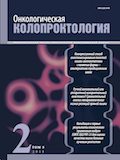Compression method of anastomosis of large intestines by implants with memory of shape: alternative to traditional sutures
- Authors: Aliev F.S.1,2, Molokova O.A.1,2, Gyunter V.E.1,2, Chernov I.A.1,2, Krutskikh A.G.1,2, Aliev V.F.1,2, Leymanchenko P.I.1,2, Azizov S.B.1,2
-
Affiliations:
- Tyumen State Medical University of the Ministry of Health of Russia
- 54 Odesskaya St., Tyumen, 625023, Russia
- Issue: Vol 5, No 2 (2015)
- Pages: 14-26
- Section: ORIGINAL REPORTS
- Published: 17.07.2015
- URL: https://onco-surgery.info/jour/article/view/131
- DOI: https://doi.org/10.17650/2220-3478-2015-5-2-14-26
- ID: 131
Cite item
Full Text
Abstract
Research objective. To prove experimentally the possibility of forming a compression colonic anastomoses using nickel-titanium devices in comparison with traditional methods of anastomosis.
Materials and methods. In experimental studies the quality of the compression anastomosis of the colon in comparison with sutured and stapled anastomoses was performed. There were three experimental groups in mongrel dogs formed: in the 1st series (n = 30) compression anastomoses nickel-titanium implants were formed; in the 2nd (n = 25) – circular stapling anastomoses; in the 3rd (n = 25) – ligature way to Mateshuk– Lambert. In the experiment the physical durability, elasticity, and biological tightness, morphogenesis colonic anastomoses were studied.
Results. Optimal sizes of compression devices are 32 × 18 and 28 × 15 mm with a wire diameter of 2.2 mm, the force of winding compression was 740 ± 180 g/mm2. Compression suture has a higher physical durability compared to stapled (W = –33.0; p < 0.05) and sutured (W = –28.0; p < 0.05), higher elasticity (p < 0.05) in all terms of tests and biological tightness since 3 days (p < 0.001) after surgery. The regularities of morphogenesis colonic anastomoses allocated by 4 periods of the regeneration of intestinal suture.
Conclusion. Obtained experimental data of the use of compression anastomosis of the colon by the nickel-titanium devices are the convincing arguments for their clinical application.
About the authors
F. Sh. Aliev
Tyumen State Medical University of the Ministry of Health of Russia; 54 Odesskaya St., Tyumen, 625023, Russia
Author for correspondence.
Email: alifuad@yandex.ru
Russian Federation
O. A. Molokova
Tyumen State Medical University of the Ministry of Health of Russia; 54 Odesskaya St., Tyumen, 625023, Russia
Email: fake@neicon.ru
Russian Federation
V. E. Gyunter
Tyumen State Medical University of the Ministry of Health of Russia; 54 Odesskaya St., Tyumen, 625023, Russia
Email: fake@neicon.ru
Russian Federation
I. A. Chernov
Tyumen State Medical University of the Ministry of Health of Russia; 54 Odesskaya St., Tyumen, 625023, Russia
Email: fake@neicon.ru
Russian Federation
A. G. Krutskikh
Tyumen State Medical University of the Ministry of Health of Russia; 54 Odesskaya St., Tyumen, 625023, Russia
Email: fake@neicon.ru
Russian Federation
V. F. Aliev
Tyumen State Medical University of the Ministry of Health of Russia; 54 Odesskaya St., Tyumen, 625023, Russia
Email: fake@neicon.ru
Russian Federation
P. I. Leymanchenko
Tyumen State Medical University of the Ministry of Health of Russia; 54 Odesskaya St., Tyumen, 625023, Russia
Email: fake@neicon.ru
Russian Federation
S. B. Azizov
Tyumen State Medical University of the Ministry of Health of Russia; 54 Odesskaya St., Tyumen, 625023, Russia
Email: fake@neicon.ru
Russian Federation
References
Supplementary files






